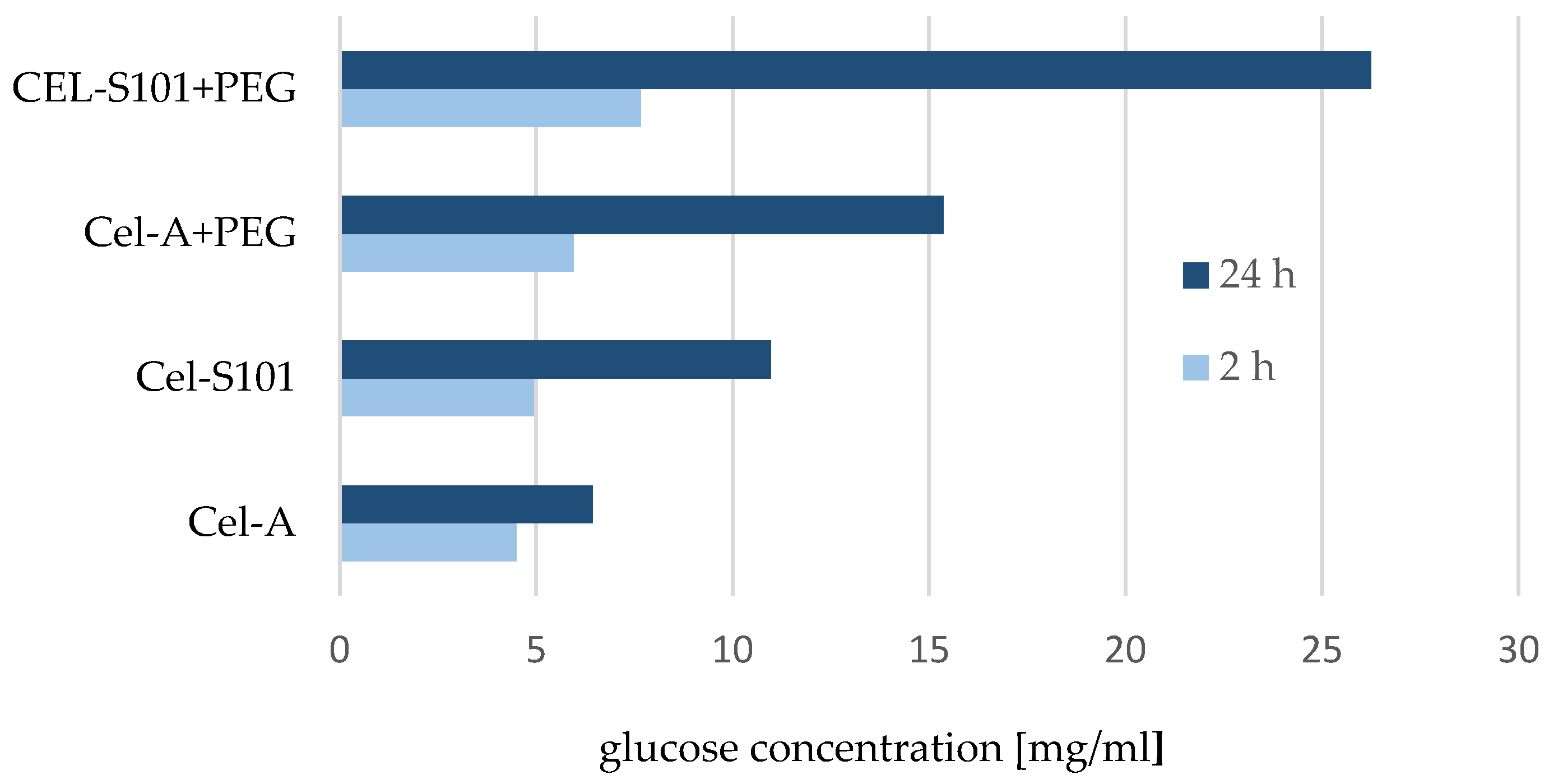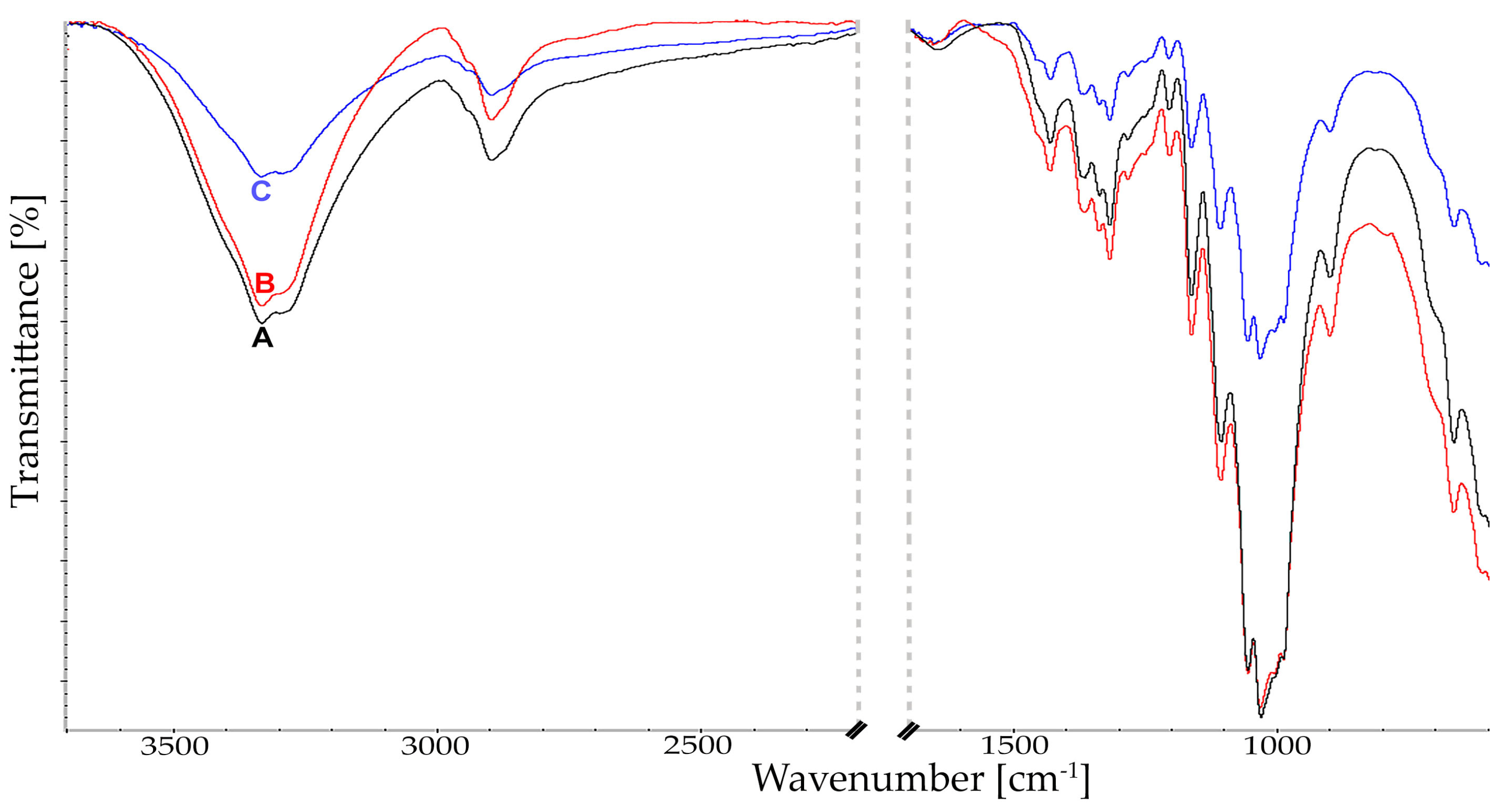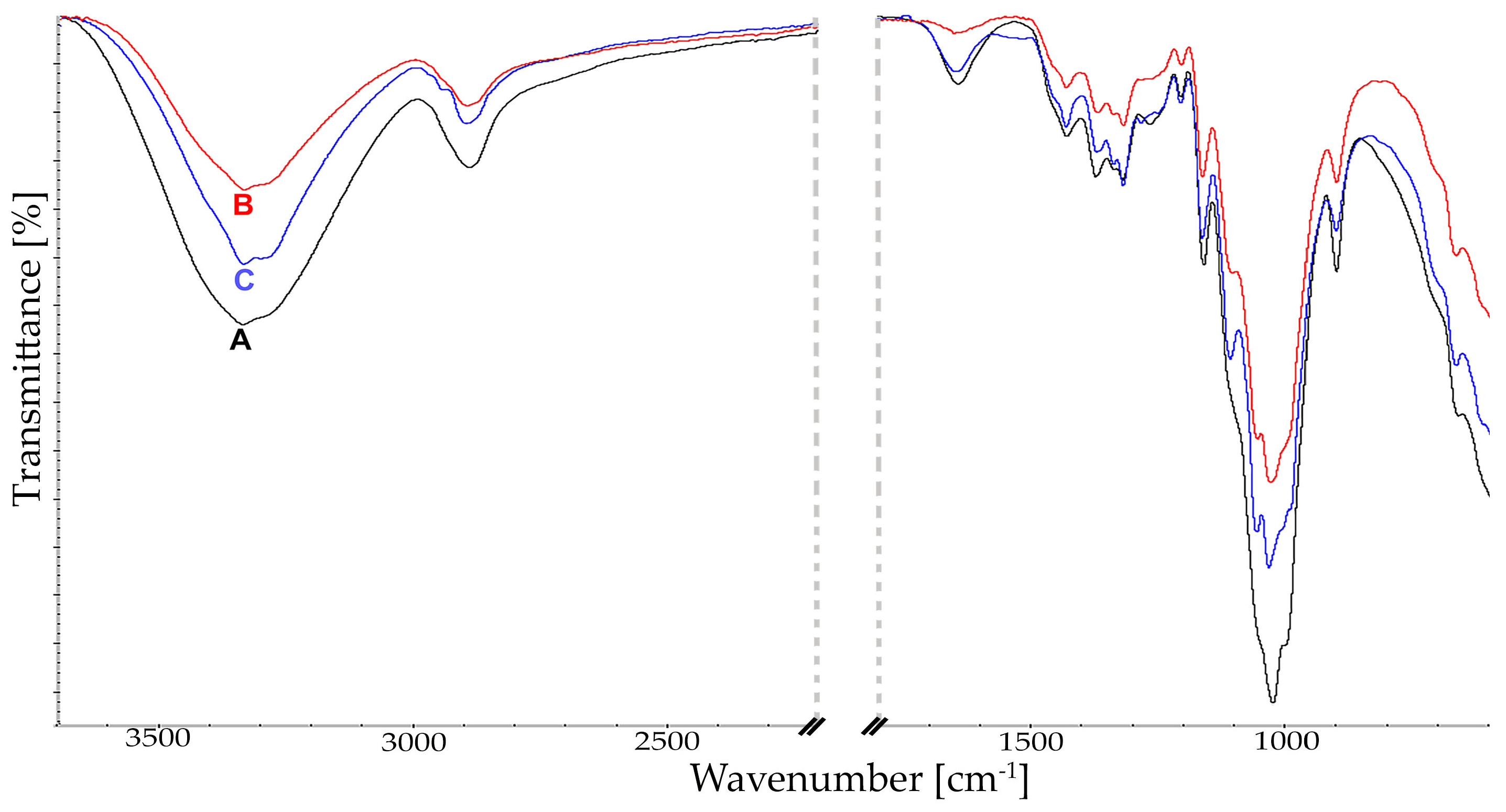The Effect of Polyethylene Glycol Addition on Improving the Bioconversion of Cellulose
Abstract
:1. Introduction
2. Results and Discussion
2.1. Analysis of Cellulose Hydrolysis Products by High-Performance Liquid Chromatography
2.2. Analysis of Structural Changes in Cellulose by Infrared Spectroscopy
2.3. XRD Investigation of Cellulose Following the Use of Polyethylene Glycol
3. Materials and Methods
3.1. Materials
3.2. The Enzymatic Treatment of Cellulose
3.3. Analysis of Cellulose Hydrolysis Products by Liquid Chromatography (HPLC/RI)
3.4. X-Ray Diffraction Analysis (XRD)
3.5. Analysis of Structural Changes in Cellulose by Infrared Spectroscopy (ATR-FTIR)
4. Conclusions
Author Contributions
Funding
Institutional Review Board Statement
Informed Consent Statement
Data Availability Statement
Conflicts of Interest
References
- Brandt, A.; Gräsvik, J.; Halletta, J.; Welton, T. Deconstruction of lignocellulosic biomass with ionic liquids. Green Chem. 2013, 15, 552. [Google Scholar] [CrossRef]
- Zielińska, D.; Szentner, K.; Waśkiewicz, A.; Borysiak, S. Production of nanocellulose by enzymatic treatment for application in polimer composites. Materials 2021, 14, 2124. [Google Scholar] [CrossRef] [PubMed]
- Al-Mardeai, S.; Elnajjar, E.; Hashaikeh, R.; Kruczek, B.; Van der Bruggen, B.; Al-Zuhair, S. Membrane Bioreactors: A Promising Approach to Enhanced Enzymatic Hydrolysis of Cellulose. Catalysts 2022, 12, 1121. [Google Scholar] [CrossRef]
- Horn, S.J.; Vaaje-Kolstad, G.; Westereng, B.; Eijsink, V.G.H. Novel enzymes for the degradation of cellulose. Biotechnol. Biofuels 2012, 5, 45. [Google Scholar] [CrossRef] [PubMed]
- Amezcua-Allieri, A.; Sánchez Durán, T.; Aburto, J. Study of chemical and enzymatic hydrolysis of cellulosic material to obtain fermentable sugars. J. Chem. 2017, 2017, 1–10. [Google Scholar] [CrossRef]
- Cao, Y.; Tan, H. Effects of cellulase on the modification of cellulose. Carbohydr. Res. 2002, 337, 1291–1296. [Google Scholar] [CrossRef] [PubMed]
- Bernardes, A.; Pellegrini, V.O.A.; Curtolo, F.; Camilo, C.M.; Mello, B.L.; Johns, M.A.; Scott, J.I.; Guimaraes, F.E.C.; Polikarpov, I. Carbohydrate binding modules enhance cellulose enzymatic hydrolysis by increasing access of cellulases to the substrate. Carbohydr. Polym. 2019, 211, 57–68. [Google Scholar] [CrossRef]
- Szentner, K.; Waśkiewicz, A.; Kaźmierczak, S.; Wojciechowicz, T.; Goliński, P.; Lewandowska, E.; Wasielewski, O. Enzymatic hydrolysis of cellulose using extracts from insects. Carbohydr. Res. 2019, 485, 107811. [Google Scholar] [CrossRef]
- Hu, J.; Arantes, V.; Pribowo, A.; Saddler, J.N. The synergistic action of accessory enzymes enhances the hydrolysis potential of a “cellulase mixture” but is highly substrate specific. Biotechnol. Biofuels 2013, 6, 112. [Google Scholar] [CrossRef]
- Bornscheuer, U.; Buchholz, K.; Seibel, J. Enzymatic degradation of lignocellulose. Angew. Chem. Itn. Ed. 2014, 53, 10876–10893. [Google Scholar] [CrossRef]
- Mansfield, S.D.; Meder, R. Cellulose hydrolysis—The role of monocomponent cellulases in crystalline cellulose degradation. Cellulose 2003, 10, 159–169. [Google Scholar] [CrossRef]
- Wiman, M.; Dienes, D.; Hansen, M.A.T.; Meulen, T.; Zacchi, G.; Liden, G. Cellulose accessibility determines the rate of enzymatic hydrolysis of steam- pretreated spruce. Bioresour. Technol. 2012, 126, 208–215. [Google Scholar] [CrossRef] [PubMed]
- Mansfield, S.D.; Mooney, C.; Saddler, J.N. Substrate and Enzyme Characteristics that Limit Cellulose Hydrolysis. Biotechnol. Prog. 1999, 15, 804–816. [Google Scholar] [CrossRef]
- Vermaas, J.; Kont, R.; Beckham, G.; Crowley, M.; Gudmundsson, M.; Sandgren, M.; Ståhlberg, J.; Väljamäe, P.; Knott, B. The dissociation mechanism of processive cellulases. Proc. Natl. Acad. Sci. USA 2019, 116, 23061–23067. [Google Scholar] [CrossRef]
- Sannigrahi, P.; Miller, S.; Ragauskas, A. Effects of organosolv pretreatment and enzymatic hydrolysis on cellulose structure and crystallinity in Loblolly pine. Carbohydr. Res. 2010, 345, 965–970. [Google Scholar] [CrossRef]
- Hall, M.; Bansal, P.; Lee, J.; Realff, M.; Bommarius, A. Cellulose crystallinity—A key predictor of the enzymatic hydrolysis rate. FEBS J. 2010, 277, 1571–1582. [Google Scholar] [CrossRef] [PubMed]
- Yang, B.; Dai, Z.; Ding, S.; Wyman, C. Enzymatic hydrolysis of cellulosic biomass. Biofuels 2011, 2, 421–450. [Google Scholar] [CrossRef]
- Ioelovich, M.; Morag, E. Effect of cellulose structure on enzymatic hydrolysis. Bio Resour. 2011, 6, 2818–2835. [Google Scholar] [CrossRef]
- Ale, F.; Castro-Muñoz, R.; Barragán-Huerta, B.; Rodríguez-Nava, O. Effect of barium addition on hydrolytic enzymatic activities in food waste degradation under anaerobic conditions. Processes 2020, 8, 1371. [Google Scholar] [CrossRef]
- Montilha, M.; Sbroggio, M.; Figueiredo, V.; Ida, E.; Kurozawa, L. Optimization of enzymatic protein hydrolysis conditions of okara with endopeptidase Alcalase. Int. Food Res. J. 2017, 24, 1067. [Google Scholar]
- Li, J.; Li, S.; Fan, C.; Yan, Z. The mechanism of poly(ethylene glycol) 4000 effect on enzymatic hydrolysis of lignocellulose. Colloid. Surf. B 2012, 89, 203–210. [Google Scholar] [CrossRef] [PubMed]
- Li, H.; Wang, C.M.; Xiao, W.; Yang, Y.; Dai, Y.; Jiang, Z. Dissecting the effect of polyethylene glycol on the enzymatic hydrolysis of diverse lignocellulose. Int. J. Biol. Macromol. 2019, 131, 676–681. [Google Scholar] [CrossRef] [PubMed]
- Hsieh, C.; Cannella, D.; Jørgensen, H.; Felby, C.; Thygesen, L. Cellobiohydrolase and endoglucanase respond differently to surfactants during the hydrolysis of cellulose. Biotechnol. Biofuels 2015, 8, 52. [Google Scholar] [CrossRef] [PubMed]
- Ouyang, J.; Dong, Z.; Song, X.; Lee, X.; Chen, M.; Yong, Q. Improved enzymatic hydrolysis of microcrystalline cellulose (Avicel PH101) by polyethylene glycol addition. Bioresour. Technol. 2010, 101, 6685–6691. [Google Scholar] [CrossRef]
- Jaszczyszyn, K. Usuwanie ze Ścieków Substancji Powierzchniowo Czynnych Niejonowych z Wykorzystaniem Sorbentów Mineralnych. Ph.D. Thesis, Instytut Inżynierii Środowiska, Poznań, Poland, 2019; p. 177. [Google Scholar]
- Sun, D.; Yang, Q.; Wang, Y.; Gao, H.; He, M.; Lin, X.; Tu, Y. Distinct mechanisms of enzymatic saccharification and bioethanol conversion enhancement by three surfactants under steam explosion and mild chemical pretreatments in bioenergy Miscanthus. Ind. Crops Prod. 2020, 153, 112559. [Google Scholar] [CrossRef]
- Zhou, Y.; Chen, H.; Qi, F.; Zhao, X.; Liu, D. Non-ionic surfactants do not consistently improve the enzymatic hydrolysis of pure cellulose. Bioresour. Technol. 2015, 182, 136–143. [Google Scholar] [CrossRef]
- Kristensen, J.; Börjesson, J.; Bruun, H.; Tjereld, F.; Jørgensen, H. Use of surface active additives in enzymatic hydrolysis of wheat straw lignocellulose. Enzym Microb. Technol. 2007, 40, 888–895. [Google Scholar] [CrossRef]
- Eriksson, T.; Börjesson, J.; Tjerneld, F. Mechanism of surfactant effect in enzymatic hydrolysis of lignocellulose. Enzym. Microb. Technol. 2002, 31, 353. [Google Scholar] [CrossRef]
- Helle, S.S.; Duft, S.J.; Cooper, D.G. Effect of surfactants on cellulose hydrolysis. Biotechnol. Bioeng. 1993, 42, 611. [Google Scholar] [CrossRef]
- Sipos, B.; Szilagyi, M.; Sebestyen, Z.; Perazzini, R.; Dienes, D.; Jakab, E.; Crestini, C.; Reczey, K. Mechanism of the positive effect of poly(ethylene glycol)addition in enzymatic hydrolysis of steam pretreated lignocelluloses. Comptes Rendus. Biol. 2011, 334, 812–823. [Google Scholar] [CrossRef]
- Zhang, M.; Ouyang, J.; Liu, B.; Yu, H.; Jiang, T.; Cai, C.; Li, X. Comparision of Hydrolysis Efficiency and enzyme adsorption of three different cellulosic materials in the presence of poly(ethylene glycol). Bioenerg. Res. 2013, 6, 1252–1259. [Google Scholar] [CrossRef]
- Li, Y.; Sun, Z.; Ge, X.; Zhang, J. Effects of lignin and surfactant on adsorption and hydrolysis of cellulases on cellulose. Biotechnol. Biofuels 2016, 9, 20. [Google Scholar] [CrossRef] [PubMed]
- Chen, N.; Fan, J.B.; Xian, J.; Chen, J.; Liang, Y. Enzymatic hydrolysis of microcrystalline cellulose in reverse micelles. Biochim. Biophys. Acta Proteins Proteom. 2006, 1764, 1029–1035. [Google Scholar] [CrossRef] [PubMed]
- Qing, Q.; Yang, B.; Wyman, C.E. Impact of surfactants on pretreatment of corn stover. Bioresour. Technol. 2010, 101, 5941–5951. [Google Scholar] [CrossRef] [PubMed]
- Lou, H.; Zeng, M.; Hu, Q.; Cai, C.; Lin, X.; Qiu, X.; Yang, D.; Pang, Y. Nonionic surfactants enhanced enzymatic hydrolysis of cellulose by reducing cellulase deactivation caused by shear force and air-liquid interface. Bioresour. Technol. 2018, 249, 1–8. [Google Scholar] [CrossRef]
- Białachowski, R.; Paukszta, D.; Lewandowicz, G. Wpływ krystalicznej celulozy siarczanowej na proces hydrolizy enzymatycznej. Nauka Przyr. Technol. 2012, 6, 1–9. [Google Scholar]
- Van Wyk, J.P.H.; Mohulatsi, M. Biodegradation of Wasre Cellulose. J. Polym. Environ. 2003, 11, 23–28. [Google Scholar] [CrossRef]
- Taherzadeh, M.; Karimi, K. Pretreatment of lignocellulosic waste to improve ethanol and biogas production: A Review. Int. J. Mol. Sci. 2008, 9, 1621–1651. [Google Scholar] [CrossRef]
- Börjesson, J.; Engqvist, M.; Sipos, B.; Tjerneld, F. Effect of poly(ethylene glycol) on enzymatic hydrolysis and adsorption of cellulase enzymes to pretreated lignocellulose. Enzyme Microb. Technol. 2007, 41, 186–195. [Google Scholar] [CrossRef]
- Zhbankov, R.G.; Firsov, S.P.; Buslov, D.K.; Nikonenko, N.A.; Marchewka, M.K.; Ratajczak, H. Structural physico-chemistry of cellulose macromolecules. Vibrational spectra and structure of cellulose. J. Mol. Struct. 2002, 614, 117–125. [Google Scholar] [CrossRef]
- Dourado, F.; Gama, M.; Chibowski, E.; Mota, M. Characterization of cellulose surface free energy. J. Adhes. Sci. Technol. 1998, 12, 1081–1090. [Google Scholar] [CrossRef]
- Borysiak, S. Influence of wood mercerization on the crystallisation of polypropylene in wood/PP composites. J. Therm. Anal. Calorim. 2012, 109, 595–603. [Google Scholar] [CrossRef]
- French, A.D. Idealized powder diffraction patterns for cellulose polymorphs. Cellulose 2014, 21, 885–896. [Google Scholar] [CrossRef]
- Lee, H.V.; Hamid, S.B.A.; Zain, S.K. Conversion of lignocellulosic biomass to nanocellulose: Structure and chemical process. Sci. World J. 2014, 4, 631013. [Google Scholar] [CrossRef]
- Grząbka-Zasadzinska, A.; Skrzypczak, A.; Borysiak, S. The influence of the cation type of ionic liquid on the production of nanocrystalline cellulose and mechanical properties of chitosan-based biocomposites. Cellulose 2019, 26, 4827–4840. [Google Scholar] [CrossRef]
- Zielińska, D.; Skrzypczak, A.; Peplińska, B.; Borysiak, S. Nanocellulose-based polymer composites functionalized with new gemini ionic liquids. Int. J. Mol. Sci. 2022, 23, 15807. [Google Scholar] [CrossRef] [PubMed]
- Lindman, B.; Karlstrom, G.; Stigsson, L. On the mechanism of dissolution of cellulose. J. Mol. Liq. 2010, 156, 76–81. [Google Scholar] [CrossRef]
- Hindeleh, A.M.; Johnson, D.J. The resolution of multipeak data in fiber science. J. Phys. Appl. Phys. 1971, 4, 259–263. [Google Scholar] [CrossRef]
- Klata, E.; Borysiak, S.; Van de Velde, K.; Garbarczyk, J.; Krucińska, I. Crystallinity of polyamide-6 matrix in glass fibre/polyamide-6 composites manufactured from hybrid yarns. Fibres Textiles East. Eur. 2004, 12, 64–69. [Google Scholar]
- Garbarczyk, J.; Borysiak, S. Kompozyty polipropylenu z włóknami celulozowymi I. Wpływ warunków wytłaczania i wtryskiwania na strukturę matrycy polipropylenowej. Polimery 2004, 49, 541–546. [Google Scholar]





| Cellulose | Crystallinity of Cellulose [%] | Increase in Crystallinity After Treatment [%] | ||
|---|---|---|---|---|
| Before Enzymatic Reaction | After Enzymatic Reaction Without PEG | After Enzymatic Reaction with PEG | ||
| Cel-A | 49 | 65 | 64 | c.a. 30 |
| Cel-S101 | 32 | 51 | 52 | c.a. 60 |
Disclaimer/Publisher’s Note: The statements, opinions and data contained in all publications are solely those of the individual author(s) and contributor(s) and not of MDPI and/or the editor(s). MDPI and/or the editor(s) disclaim responsibility for any injury to people or property resulting from any ideas, methods, instructions or products referred to in the content. |
© 2024 by the authors. Licensee MDPI, Basel, Switzerland. This article is an open access article distributed under the terms and conditions of the Creative Commons Attribution (CC BY) license (https://creativecommons.org/licenses/by/4.0/).
Share and Cite
Szentner, K.; Waśkiewicz, A.; Imbiorowicz, R.; Borysiak, S. The Effect of Polyethylene Glycol Addition on Improving the Bioconversion of Cellulose. Molecules 2024, 29, 5785. https://doi.org/10.3390/molecules29235785
Szentner K, Waśkiewicz A, Imbiorowicz R, Borysiak S. The Effect of Polyethylene Glycol Addition on Improving the Bioconversion of Cellulose. Molecules. 2024; 29(23):5785. https://doi.org/10.3390/molecules29235785
Chicago/Turabian StyleSzentner, Kinga, Agnieszka Waśkiewicz, Robert Imbiorowicz, and Sławomir Borysiak. 2024. "The Effect of Polyethylene Glycol Addition on Improving the Bioconversion of Cellulose" Molecules 29, no. 23: 5785. https://doi.org/10.3390/molecules29235785
APA StyleSzentner, K., Waśkiewicz, A., Imbiorowicz, R., & Borysiak, S. (2024). The Effect of Polyethylene Glycol Addition on Improving the Bioconversion of Cellulose. Molecules, 29(23), 5785. https://doi.org/10.3390/molecules29235785







